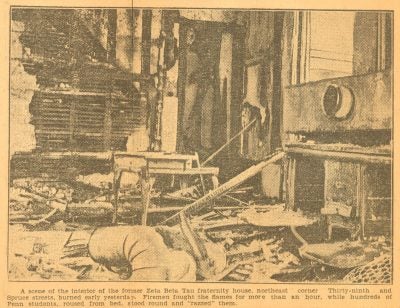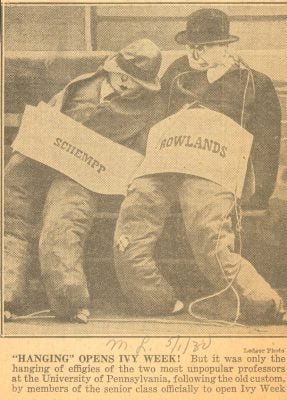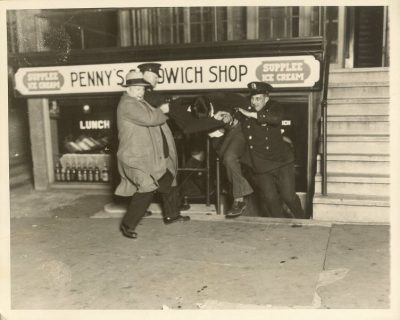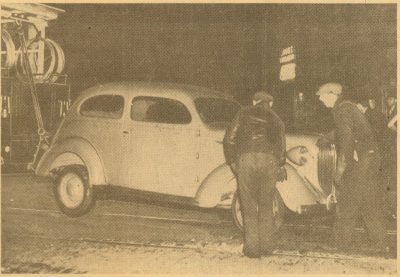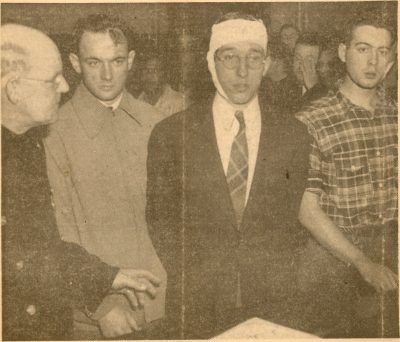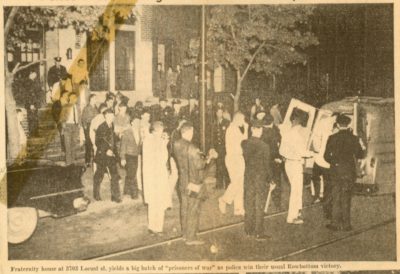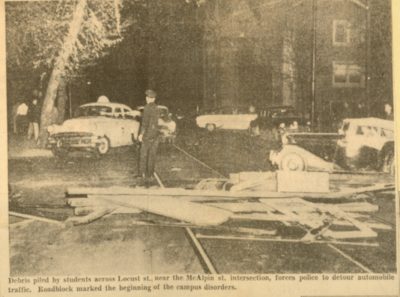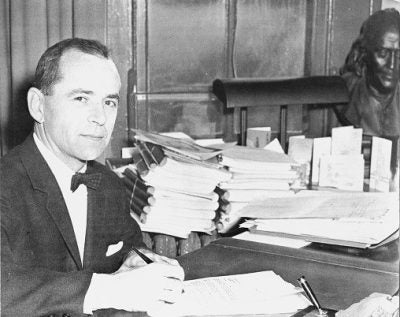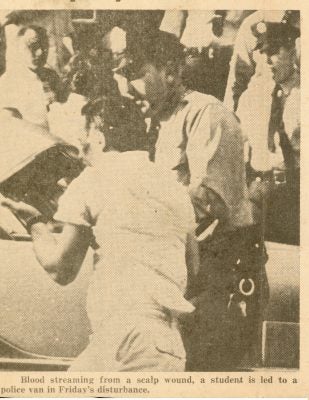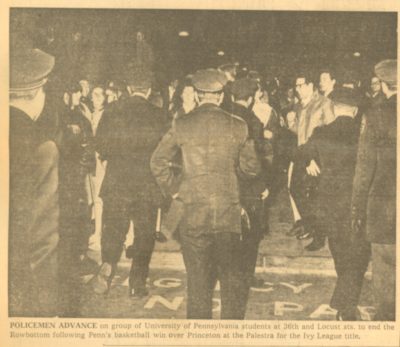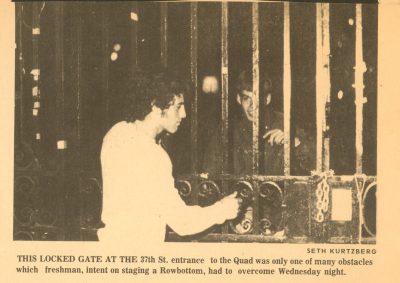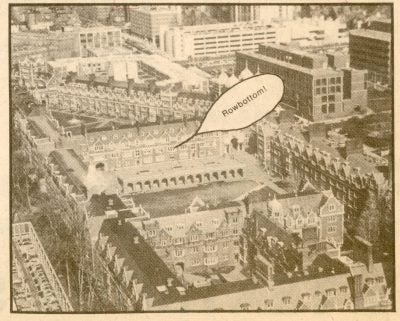1910: The Call of "Rowbottom" Begins
- Crockery Smash and More
On warm nights students often gathered in the dormitory triangle to vent their energy by wrestling, smashing crockery, or some other horseplay. The wildest melee of the year began as pitchers, bowls, light bulbs and other University property were thrown out dormitory windows. Student cat calls, blasts from brass musical instruments, the shooting of revolvers, and fire crackers-all added to the cacaphony. When there was nothing left to throw, the young men gathered to watch fire works and then to dance and sing around a bonfire they built at the lower end of the triangle. After two hours, dormitory officials broke up the disturbance. According to a city newspaper, the call of “Yea, Rowbottom” was the rallying cry.View facsimile of news articles from the Daily Pennsylvanian, 1910 May 12, and from the Philadelphia Ledger, 1910 May 30
- May 1910 – Comet Party
Students, finding the stellar performance to be disappointing, took out their frustrations on trolley poles, pulling the poles from the overhead wires.As remembered by members of the Class of 1913 in the Philadelphia Record, 1930 May 3
1928
- March 20 – after the Penn basketball team defeated Princeton to become Intercollegiate League champions
There was no rioting at the end of the game while police were present, but after police departed, the wild revelry began. A crowd of about 1000 students set fire to trolley wires, pulled trolley poles from overhead wires, and lit bonfires in front of Psi Upsilon Fraternity. When firemen arrived, different groups of students carried off the fire hose, made away with a large red Philadelphia Rapid Transit automobile trailer, and changed the workings of the “automatic traffic semaphore.” Seventeen students were arrested on a charge of inciting a riot. Damage paid by the students included $800 for damage to PRT equipment and $59 for torn uniforms. Included among the arrested students were Jack McDowell, president of the senior class who was arrested as he tried to quell the disturbance, and Thomas S. Gates, Jr., manager of the football team who was arrested when he went to the station house to gain the release of McDowell. It is interesting to note that young Gates would become a banker and Secretary of the Navy under the Eisenhower administration; at the time of his arrest his father, Thomas Sovereign Gates, Sr., was a prominent lawyer and also a University trustee, who would be named Penn’s President in 1930. - May 21 – after a power failure in West Philadelphia
Members of the Kappa Alpha Phi fraternity threw bricks at passing vehicles and then assaulted police who tried to enter the house. Ten students were arrested, but charges were dismissed after Judge Hamburg gave them a stern lecture. One student, senior Huber M. Gemmill, was charged with assault and battery on a police officer, interference with a police officer, malicious mischief and inciting of riot and held on $300 bail. The concerned police officer, however, dropped the charge and Gemmill was released in time for graduation.
1929
- April 9 – when asked by the magistrate why they started the riot, the students replied, “We didn’t have any fun for a long time”
Students took control of traffic lights at the intersection of 37th Street, Spruce Street and Woodland Avenue and then, from the dormitories, pelted police with a barrage of milk bottles. On Locust Street, between 37th and 38th Streets, students tore up paving blocks and used a Pennsylvania Rapid Transit toolbox and night watchman’s shed to set up a barricade. Several hundred students were involved; twenty-three were arrested, but later released. - May 12 – during final exams
About 500 students again took control of the traffic lights at the same intersection. Trolley poles were dislodged and policemen bombarded with eggs, but only one student was arrested (for throwing automobile wheels at the police). - October 19 – after a Penn vs. University of California football game
It was reported that the trouble started once again at the intersection of Woodland, Spruce and 37th streets. Apparently students on the trolleys refused to pay their fares and then, when conductors attempted to prevent them from leaving, the students smashed windows. Other students (many in their pajamas since it was 1 a.m.) poured out of dormitories to build bonfires in streets around campus and to yell and snake dance to college songs. Four junked automobiles were pushed to the middle of Locust Street and burned. Police and firemen were called, but only one student was arrested; when he proved to be just a passerby, he was released. - October 27 – after a Penn football victory over Lehigh
A rash of suspicious fires in the neighborhood during recent weeks had included a fire at the former Zeta Beta Tau fraternity house at 39th and Spruce streets. The fraternity had already vacated the building because of fire damage eight years earlier. Sometime after midnight on October 27, students approached the vacant Zeta Beta Tau fraternity house, breaking branches from trees and pulling down trolley poles. As the young men tore down the fence around the one-time fraternity house, a student shouted “Let’s set it on fire again.” Alert fire marshals were inside waiting, however. Though outnumbered, firemen managed to arrest three students, all of whom were jailed for ten days each on charges of disorderly conduct.View facsimile of news article from the Philadelphia Record, 1929 October 29
1930
- April 29 – revival of the custom of burning unpopular professors in effigy led to over reaction by police and then to “Rowbottom”
In a revival of a practice formerly associated with the tradition of Sophomore Cremation, students burned in effigy two dummies of professors David T. Rowlands and Edwin K. Schempp on Woodland Avenue, between 36th and 37th streets. Eyewitnesses, both students and professors, insist there was no violence until a policeman became excited and phoned in a riot call.It was not until police arrived en masse to collar and drag students into the patrol wagons that the cry of “Rowbottom” rang out, with some students throwing bottles, cans, shoes and alarm clocks towards the police. Police with blackjacks followed fleeing students into nearby shops, smashing display cases as they grabbed students and anyone else inside. Police entered nearby fraternity houses by shooting locks off fraternity house doors and dragged out students, many in their night clothes.
At least three hundred students were arrested. A few were quickly released when University officials vouched for their innocence, but upon hearing that these students were rejoining the ongoing rioting, the city’s Director of Public Safety Lemuel B. Schofield refused to release more students. Schofield soon clashed with magistrate J.J. O’Malley, who was working at the request of University officials and students for the release of students. As a result, Schofield landed up in Moyamensing county prison on charges of obstructing justice and resisting arrest until another judge, Penn alumnus Howard A. Davis, freed Schofield and delivered a scathing indictment of Penn students.
Interestingly, Schofield was a 1913 Penn graduate and valedictorian of his class. According to an article in the May 3, 1930 Philadelphia Record, although Schofield, as an undergraduate, “was not in any sense a leader of [the 1910-1913] ‘Rowbottoms,’ he was always one of the crowd, doing his share to bait police and storekeepers and to drive trolley conductors frantic.”
The public image of Philadelphia police was damaged when the dramatic story lingered on the front page of local papers for several weeks. The Penn student newspaper described the police as “cossacks.” Philadelphia newspapers published criticism of police actions by the owners of Beaston’s Pharmacy and reports that members of Phi Sigma Kappa fraternity were pressing charges against police. The University also announced its intention to prosecute police. As the Trustees launched an investigation, Provost Josiah H. Penniman gave a speech, encouraging an end to “Rowbottoms” but also speaking out against the beating of students and the damage to property resulting from “unprovoked police brutality.”
View facsimile of sample newspaper coverage in Philadelphia Record, 1930 May 2, and of the complete text of Provost Penniman’s speech to students
Provost Penniman solicited eyewitness accounts of the April 29 Rowbottom, and received dozens of replies. These documents present a wide range of perspectives on actions by students and police. Compare for example the letters of neighborhood resident Mrs. Willie Stein of 3816 Locust Street and of medical student Park Weed Willis, Jr., M.D. 1931.
- May 1 – A Peaceful Rowbottom
Only three policemen were present and did not interfere as students gathered at 38th and Locust. Speeches were given by a student and a chaplain, followed by cheers for the success of the baseball team and crew team at upcoming sports events. A request for “Hail Pennsylvania!” was followed by many more songs; there was much noise, but no trouble.View facsimile of news article from the Philadelphia Record, 1930 May 2
1932
- October 14- before a Penn vs. Dartmouth football game
After a pep rally and parade led by the band, a few students pulled trolley poles from their wires in an attempt to start a Rowbottom. Other students, however, quickly replaced the poles and a riot was avoided. - November 4 – before a Penn vs. Pitt football game
When students started a disturbance on their way to a rally in Weightman Hall, police quickly restored order. Trouble began again after the rally when about a dozen students climbed onto the automobile of a passerby; when the driver lurched the car to clear a path, one student was injured as he was hurled from the running boardLater in November, the University of Pennsylvania banned Rowbottoms in an edict issued by Charles H. Coogan, chairman of the University’s parietal committee. All students were issued a copy of the new rules which stated:
They [the students] must respect the rights and property of all persons and at all places. They must not interfere with or inconvenience traffic of any kind on or off the campus
1933
- June 10 – a hot night at a fraternity house
At the request of neighbors, police responded at 1 a.m. as students threw chairs, books and glassware from the windows of the Kappa Sigma Fraternity at 3706 Locust Street. When pistol shots did not end the melee, police broke into the house and arrested eleven students and graduates for disturbing the peace. The young men spent the night in a cell at the police station at 32nd Street and Woodland Avenue before being released. - November 16 – freshmen rebel against sophomores in a noisy but bloodless Rowbottom
Freshmen announced that they would no longer submit to the regulations set down by the sophomores, shouting challenges to the sophomores and calling on them on fight. When the sophomores did not respond, freshman purloined an auto parked at 37th Street and Woodland Avenue and pushed it down a flight of stairs to the sophomore side of the quad. There was no fight and no arrests.
1934
- June 5 – end of the academic year
Approximately 1500 students participated as this Rowbottom spread through the dorms and across the campus late Monday night and early Tuesday. On the streets, fire hydrants were opened, trash cans were tipped into the road, newsstands were overturned and bottles crashed through windows of cars and trolleys. At the Pennsylvania Hotel at 40th and Walnut Streets, glasses were thrown, tables overturned and a chandelier pulled from the ceiling as young men swung like monkeys.Eighteen of the 64 students arrested were released after police were convinced of their innocence, but 46 students were held in jail. The scantily-clad gentlemen were tried the next day in the court of Magistrate Hamberg. After lawyers and W. Chattin Wetherill, director of student welfare, pleaded that the students had examinations the next day, the ten dollar fines for each convicted student were suspended and all were released. Students cheered the magistrate as they left the court room. Six false alarms were sent in from around the campus that night, the students’ parting shots of the 1934 Rowbottom. The University, however, had the last word; when thirty-five of the students were ordered to appear individually before a University panel, ten students were singled out as the most flagrant offenders.
View facsimile of news article from the Philadelphia Evening Bulletin 1934 June 5
1935
- February 16 – at a student performance
When students disrupted the singing of “Merrily We Roll Along” with catcalls and rhythmic stamping, police quickly took control.
1937
- November – before a Penn vs. Cornell football game
A relatively tame Rowbottom resulted in the arrest of three students. They were later released with a warning that they would get a six-month sentence if they were caught again.
1938
- November 21 – before a Penn-Cornell football game
In the worst Rowbottom since 1930, two thousand students took part in three hours of destructive mayhem. It began shortly after 7 p.m. as students leaving a pep rally at 37th Street and Woodland Avenue began crying “Yea, Rowbottom.” Soon campus streets were littered with ashes and garbage, broken glass, smashed eggs and bonfires fueled by newspapers. Trolley poles were pulled from their wires and parked cars lifted unto the tracks. Police, motormen and pedestrians were pelted with rotten eggs, bottles, bricks and other debris. Tires of parked cars were deflated or slashed. The drivers of hundreds of stalled cars honked their horns and police sirens wailed. By the time firemen’s hoses and police squads brought things under control, seven trolley riders and four transit employees had been injured, one motorman had been hospitalized, and 35 students were arrested. President Gates expressed regret over the incident, but put some of the blame on actions of outsiders who participated in the disturbances.View facsimiles of sample newspaper coverage in Philadelphia Record, 1938 November 22, and Evening Public Ledger, 1938 November 22
1939
- November 21 – occurred about the time of the Penn vs. Cornell football game, but was also rumored to be related to the recent suspension of ten Punch Bowl editors for the printing of ribald humor in a recent issue
About a hundred students gathered in the neighborhood of the fraternities near 37th and Spruce Streets. A few trolley car poles were detached from their overhead wires, some automobile tires were deflated, a stop sign was pulled out and a bonfire lit; but this Rowbottom was easily broken up by police.
1940
- October 24 – after a raucous sendoff of the Penn football team as they boarded trains at 30th Street Station for a game with Michigan
About 1, 500 students held up traffic as they proceeded single file back to campus via Woodland Avenue. As firecrackers were thrown in the path of trolley cars, shouts of “Rowbottom” echoed down fraternity row. When police in motorcycles sped up and down the sidewalks, most students dispersed but two policemen were pelted with tomatoes and eggs. The fifteen students were taken to the police station at 32nd Street and Woodland Avenue were released without being charged. Another Rowbottom was nipped in the bud. - November 22 – before a Penn vs. Cornell football game
Early in the evening “good-natured” students pulled down trolley poles, blocked traffic, threw eggs, and resisted police attempts to disperse them. By midnight, however, the mood changed. Stones, rotten fruit, and water were thrown at police, often from the windows of fraternity houses. Three students, charged with attacking police, were taken to the hospital with head injuries before spending the night in the police station; they were convicted by the magistrate the next morning, but their sentences were quickly suspended. Newspapers generally criticized student rioting, but some also spoke out against alleged police brutality used to break up the Rowbottom.The University was prompted by this Rowbottom to adopt a firmer stance toward student offenders. One student was immediately suspended until after the Christmas recess. When students returned in January, Provost Thomas S. Gates announced that the University would no longer dismiss Rowbottoms as an outlet for youthful enthusiasm; such student disorders were now to be banned, with any student participants being expected to take the consequences.
View facsimile of news article from the Philadelphia Bulletin, 1940 November 23
1941
- September 29 – freshmen rebel against hazing by sophomores
Never before had a Rowbottom occurred so early in the academic year. The trouble started after a few of the sophomores in charge of freshmen supervision entered the freshman quad and called out a hundred freshmen to sing. Freshmen chased off the sophomores and then emptied trash and built a bonfire, burning their freshmen caps and buttons. After the call of “Yea, Rowbottom!” went out, four hundred furious freshmen backed six hundred upperclassmen into the upper dormitory quadrangle.Upperclassmen avoided the ignominy of defeat only when fellow classmates on the upper floors poured fruit and ashcans of water on the battling freshmen. After police calmed things down, the Undergraduate Council charged the sophomore supervisors to be guilty of negligence.
- October 2 – before a Penn vs. Harvard football game
A mini-Rowbottom was staged at Spruce Street and Woodland Avenue at about 11 p.m. the night before the game. Cars were dragged into the intersection to halt traffic, a bonfire burned, and eggs were thrown. Police, however, had been forewarned and quickly ended the melee. - November 20 – before a Penn vs. Cornell football game as students gathered in front of College Hall, around the statue of Ben Franklin, for a pep rally
At the end of the pep rally school spirit took a violent turn. Once again parked cars were moved to block the intersection of Spruce and Woodland, trolley poles were pulled from their wires. Students poured out of the dormitories to riot over a ten-block area, stoning police cars and throwing firecrackers, milk bottles and bags of water at police. Also featured in this Rowbottom were a fire alarm, a sit-down of 150 students in the middle of Woodland Avenue, the theft of the keys to a police car, and the recruitment of about a hundred younger boys (many still in knee-pants) from the neighborhood.This full-scale Rowbottom lasted four hours and led to the arrest of four students on riot charges, injuries to a dozen students, and the hospitalization of a ringleader. The University’s handling of the event revealed the University’s commitment to its new and tougher policy. During the riot, University proctors took down the names of students they could identify. The day after the event the University publicly apologized for the Rowbottom. Within six days, one student had been dismissed, four had been suspended and four others had been placed on conduct probation. And for the first time, when arrested students faced the magistrate, no representative of the University appeared at the hearing to offer bail or to plead on their behalf. Four students remained in jail for eight days before the University intervened, the students apologized and charges were dropped.
View facsimiles of news articles from the Philadelphia Record, 1941 November 21 and the Philadelphia Evening Bulletin, 1941 November 21
1945
- August 14 – V-J Day
A Rowbottom, staged to celebrate the end of World War II, lasted for two hours.
1946
- October 11 – before a Penn vs. Dartmouth football game
After a pep rally at the rear of Houston Hall, several thousand singing and cheering students participated in a Rowbottom along Woodland Avenue, between 36th and 38th Streets. Minutes after shouts of “Rowbottom” went out, trolley poles were pulled down and cars pushed unto the trolley tracks. As the disturbance escalated, eggs and overripe fruit were hurled, barrels rolled into the streets, gasoline poured unto the trolley tracks and ignited, and ignition keys for police cars were stolen. In this first major Rowbottom after World War II, even coeds enthusiastically participated. One policeman suffered an eye injury and three students were taken into custody. Police reinforcements arrived, firing blank cartridges, but it was a sudden, driving rain storm that brought the disorder to a halt after a half-hour of rioting. As a result of this Rowbottom, the University suspended two students and banned student football rallies indefinitely.View facsimile of news article from the Philadelphia Record, October 12, 1946
- November 14 – before a Penn vs. Army game
At about 8 p.m. on a Thursday night a student in a crowd at 37th Street and Woodland Avenue gave the rallying cry of “Rowbottom!” At once students poured out of the dormitories, fraternities and sororities to begin four hours of rioting. Three hundred policemen struggled to restore order as students cut trolley wires, set kerosene fires on the tracks, pushed some cars to the middle of the street and overturned others, swarmed through the Hotel Philadelphian, and pelted police, firemen, and transit repairmen with whatever was available. By the end of the fracas, one student had been arrested and forty trolley cars stalled. The crews of fire engines 5 and 67 reported the theft of helmets, rubber boots and coats, axes and crowbars, a hose nozzle and the top of its bell.The very next day University suspended three students as President George W. McClelland issued a strong condemnation of the disorders. In response to the pleas of responsible student leaders, however, the University agreed to temporarily lift the ban against pep rallies to allow a noon rally to be held under University supervision. Dean Arnold K. Henry and Coach George Munger and members of his football team were speakers at this peaceful rally attended by about 3,500 students. Eventually most of the fire equipment was returned by students, but the University still paid $879 in damages for repairs to automobiles, broken windows, street signs and fire equipment.
View facsimile of news article from the Philadelphia Bulletin, November 15, 1946
1947
- October – student groups ban Rowbottoms
Rowbottoms were banned by all thirty-five fraternities at the University plus many other student organizations such as the Sphinx Senior Honor Society, the Dormitory Council, and the Friars Senior Honor Society.View facsimile of news article from the Philadelphia Daily News, October 10, 1947
1950
- January 14 – after a 1 a.m. raid by the police vice squad on Smokey Joe’s Tavern on 36th Street below Walnut Street
When police arrested sixteen men and two women and attempted to load them into patrol wagons, the trouble began. Since most of the hundred or so boisterous patrons of Smokey Joe’s were Penn students, word of the police raid spread quickly. Amid calls of “Rowbottom,” hundreds of students emerged from fraternities and dorms to sing college songs and jeer police. Police reinforcements averted a major riot, and those arrested in the tavern were transported to City Hall where they were charged with intoxication, selling liquor to minors and other violations of liquor laws.View facsimile of news article from the Daily News, January 14, 1950
1952
- May 20 – as Penn students expressed their enthusiasm for “panty raids” that swept colleges across the nation this spring
After someone tipped off the police, officers formed a tight cordon around Sergeant Hall, the women’s dormitory at 34th and Chestnut Streets. Two fire companies were also on the scene, with hoses attached to fire plugs and ready to be used on rioters if needed. Inside, the young women inside locked their doors, turned out their lights, and hid their underwear. When thousands of Penn students marched on Sergeant Hall and then the nurses’ dormitory (Kings Court at 36th and Chestnut Streets), their calls for “Rowbottom!” were effectively countered by police and firemen before a major riot occurred.In the end, Penn men were unsuccessful in their quest for women’s underwear. One nursing student was hospitalized when a cherry bomb thrown into the nurses’ dorm resulted in her temporary loss of hearing. Although rioting students also pulled down trolley poles and broke windows, the damage was minor compared to earlier Rowbottoms. Punishment, however, for those students who were apprehended was swift and firm. A hundred students were carted off to the police station; no charges were filed, but twenty young men were turned over to the University for discipline. The University’s seven-member committee on discipline, which included three students, voted to suspend ten students.
View facsimile of news articles from the Daily News, May 21, 1952 and the Philadelphia Inquirer, May 21, 1952
1953
- March 26 – before Easter vacation
For a few nights, groups of from three to fifteen students staged sporadic, hit-and-run Rowbottoms, upsetting garbage containers and mail boxes, snapping car aerials and breaking into cars, disabling traffic lights and smashing a store window. On Sunday night alone, police received more than fifty telephone calls reporting damage. At least nine students, including a member of the track team, were arrested by police. - May 20 – Spring Fever
From about 9:30 p.m. until 3 a.m. police and firemen were kept busy breaking up groups of students shouting, singing, and jeering law enforcement officers. Firemen were called to extinguish three fires: a fire from an overturned pot of pitch at 39th and Locust Streets at 10 p.m., a bonfire on the sidewalk in the 200 block of South 37th Street at 1 a.m., and a blaze in the middle of Locust Street between 36th and 37th Streets an hour later.
1955
- April 23 – celebration of the Child’s Cup victory of the Penn crew team during Skimmer Day
An estimated seven hundred students, from Penn and other institutions, participated in this three-hour melee. Celebrants stalled six trolley lines by removing their poles from the overhead wires. They also let air out of automobile tires and threw beer bottles at police, injuring several. Police arrested students in the streets, including a young woman (not a Penn student) who ran through the crowds yelling for rioters to get police badge numbers; one student was arrested for unlocking the back door of a paddy wagon as it headed to the police station with arrested youths. Officers also pursued students into several fraternity houses. A Drexel student, a visiting salesman and his girl friend, and forty-two Penn men were arrested, lectured and released; another three were each fined $10 and costs. The University suspended two students and placed eight others on “conduct” probation barring them from extracurricular activities, including sports. Three fraternities (Phi Sigma Delta, Sigma Alpha Epsilon and Delta Kappa Epsilon) were also placed on “social” probation until December, barring women guests from the fraternity houses and prohibiting the fraternities from sponsoring any social events where women would be present.View facsimiles of news articles from the Philadelphia Inquirer, April 24, 1955 and the Pennsylvania Gazette, June 1955
- May 3 – during fraternity pledge week
At about 8 p.m. fraternity men began this Rowbottom by blocking traffic on Locust Street at McAlpin (between 36th and 37th Streets). As boisterous students built this blockade with beams, window sashes and other wreckage from an adjacent house demolition, at least a half dozen police cars arrived on the scene to be greeted with jeers and pelted eggs from the students. When students made moves to add cans of yellow paint to the mix, police entered the fraternity houses and made mass arrests. Of the 116 students arrested, twenty-eight were held for grand jury action. The University’s committee on discipline at first suspended fourteen other students for the entire first semester of the coming academic year as well as for the rest of the current semester (to June 30), but this sentence was later reduced to only the remainder of the current semester and the first week of the fall semester. A dozen other students were subjected to lesser disciplinary measures such as suspension for the remainder of the semester or conduct probation.View facsimile of news article from the Philadelphia Inquirer, May 5, 1955
- May 20 – no associated event
From about 2 a.m. until 3 a.m. about a hundred students staged a Rowbottom between 36th and 39th Streets, on Locust and Walnut Streets and on Woodland Avenue. Rioting students not only upset garbage cans, broke windows and taunted police, they also dropped an iron subway grating down the eighty-foot shaft and rolled a large spool of cable down a hill so that it smashed a parked car. As a result, twelve students were arrested and fined $5 each plus $2.50 in costs. The University’s committee on discipline suspended two students and placed two others on conduct probation, banning them from all nonacademic University activities.
- May 28 – no associated event
This Rowbottom involved about twenty-five students gathered on the sidewalk and on the roof of Beta Sigma Rho fraternity house near 39th and Spruce Streets. The young men hurled eggs and tomatoes and squirted water at passing cars and trolleys. When police were first called, they issued only a warning to the students. When another complaint was phoned in, police returned and arrested twelve students. In police court, the magistrate fined each of them $5 plus $2.50 in costs. The University’s committee on discipline put two students on conduct probation, banning them from all nonacademic University activities.
1956
- March 19 – snowball fight
After about 25 complaints from people pelted by snowballs at 36th and Locust Streets, twelve policemen raided the intersection. When some of the students ran into the Delta Tau Delta fraternity, police followed and rounded up 24 students, including the photographic editor of the Daily Pennsylvanian student newspaper. They were released with a warning from the judge - May 3 – during spring pledge week
This major Rowbottom began at about 9 p.m. on a Thursday night and lasted until 2 a.m., with a brief lull after police hauled away the first batch of troublemakers at about 10 p.m. As on last May 3, the trouble began at a demolition site at the corner of Locust and McAlpin, and soon encompassed the entire stretch of fraternity houses and boarding houses on Locust between 36th and 38th Streets. Students began by ripping debris from the demolition site and throwing this debris into Locust Street. Soon they were also throwing bottles and eggs and jeering police. As more and more police cars arrived, students retreated from the street to throw eggs, firecrackers, ashtrays and other found objects from porches, roofs and windows. Later, after the first roundup of students, students again gathered on Locust Street, this time adding rocks to the mix being hurled at police. In the midst of this chaos, firemen arrived to answer a false alarm from a nearby location.After Dean George B. Peters joined law enforcement officers at the scene, the dean and the police together decided that the only way to restore order was to round up as many rioters as possible. Every time a window opened, police dashed in to grab as many students as they could, thereby cleaning out three fraternities (Kappa Sigma, Kappa Nu and Theta Xi). The process entailed a good deal of tussling and many a kick in the shin and even a few minor injuries to police; it took 48 policemen and 22 police cars to quell the disturbance.
A total of 138 students were carted off to neighborhood police stations and then, when these cells overflowed, to City Hall where they were fingerprinted. After being held overnight with ten or twelve students to a cell, most students were released, but 28 students were held on $500 bail. One student, Everett Gage, would be indicted on July 13 by a grand jury on charges of assaulting a police officer during the disorders; he was acquitted in November 1957.
Gaylord P. Harnwell, then president of the University, apologized for the trouble students had caused; police, however, demanded not just an apology, but a pledge by the University to end student riots. After Dean Peters and the committee on discipline conducted an exhaustive investigation of the accused rioters, 25 students were disciplined. Twenty students were suspended, one for one week, five until June 30 of that year and fourteen until February 1957. Five other Penn men received conduct probations, one student for only a week but four students until June of 1957. Six fraternities were placed on social probation, meaning that women guests were not allowed in the fraternity houses and that the fraternities could not sponsor any social events where women would be present; two of Penn’s oldest fraternities, Phi Sigma Kappa and Delta Psi, received the longest probations, until February of 1957. The day after the riot, Penn president Gaylord P. Harnwell apologized for the trouble students had caused; police, however, demanded not just an apology, but a pledge by the University to end student riots.
View facsimiles of news articles from several Philadelphia papers: Evening Bulletin, May 4, 1956, Daily News, May 4, 1956 and the Philadelphia Inquirer, July 14, 1956
- September 27 – in a letter to returning students, President Harnwell stated that there would be no more “riots of spring” on Penn’s campus
- October 6 – after a Penn vs. Dartmouth football game, Penn’s first varsity victory in three years
Students returning from the stadium were joined in their victory celebration by students streaming out of dormitories. For about ten or twenty minutes the cheering students blocked traffic at 37th Street and Woodland Avenue. After one student threw a milk bottle from a dorm window, other students began to toss out rolls of torn tissue paper and one young man hoisted a wooden barrel on top a pole at the subway station. At that point the lone policeman on duty called for help, and when five police cars and two emergency wagons arrived, students dispersed. The only person arrested was not a Penn student. The Philadelphia Inquirer newspaper called the entire incident a “rhubarb” rather than a Rowbottom.
1957
- January – arson near the Penn campus
During the night of January 15, a fire started in trash outside of Sol’s luncheonette at 3701 Spruce Street, across the street from the Quad dormitories. When firemen arrived at the scene, a jeering crowd of students impeded the laying of hose to put out the fire. The fire was extinguished successfully, but a Penn dental instructor, a middle-aged steelworker and a Penn student were arrested.During the night of January 21, five separate blazes were started in neighborhood trash cans. Firemen put out fires in alleys and behind buildings near 37th and Spruce, in the 3700 block of Locust Street, at 37th and Walnut Streets. Six students were taken into custody and later released.
- November – Penn announced the end of Rowbottoms
After the acquittal of the Penn student indicted in the May 3, 1956 Rowbottom, the Penn administration declared an end to these riots. University officials and the undergraduate council joined together to warn students of their obligations and of the necessity to behave responsibly.
1958
- April 17 – as students raced sports cars on Locust Street
The cry of “Rowbottom” first went out at about 7:30 p.m. from a crowd of students at 36th and Locust Streets. After fire crackers went off, five police cars arrived to arrest six students and temporarily restore order. By midnight more crowds gathered, this time about a thousand students on 37th Street at Spruce and at Locust Streets. After firemen responded to a false alarm at 3714 Spruce Street and barricades were set afire at 36th Street and Woodland Avenue, police arrived again. Students cried “Rowbottom” and pelted police with empty beer cans, eggs and firecrackers; one student even used a toy machine gun which made quite a noise. The disturbance ended with the arrest of another six students.The next day the judge dismissed all charges, but not before giving the students a stern lecture. On April 23, the University suspended four undergraduates and placed eleven others on conduct probation for the remainder of the semester. Later in the fall, Dean George B. Peters formed a University committee to discuss relations between the University and city police, with particular attention to a police proposal that the University rather than police handle future student disturbances. The city was concerned about the drain on its finances and manpower, especially when firemen and police were diverted from responding to real fires and major crimes.
View facsimiles of news articles from the Daily News, April 18, 1958 and the Daily Pennsylvanian, November 3, 1958 as well as the obituary of Dean George B. Peters
1959
- April 8 – spring revelries
This Rowbottom, involving about 500 students, included exploding firecrackers and a bonfire, fueled by bushes (ripped from a nearby lawn) and gas (siphoned from a parked car), in the middle of Locust Street. When police arrived on the scene, the call of “Rowbottom” brought more students from dormitories and fraternity houses to move about singing, yelling and hurling eggs at policemen. In accordance with the recent change in policy shifting responsibility more toward the University, policemen were aided in their efforts by fourteen student guards who took student identification cards. By 9 p.m. order had been restored. Twelve students were hauled to the police station at 55th and Pine Streets, where they were released with instructions from the magistrate to report to the office of Dean George B. Peters the following morning for possible disciplinary action.View facsimile of news article from the Philadelphia Inquirer, April 9, 1959 and the reminiscences of alumnus Paul Kelly
1960
- March 28 – balmy spring weather
Chanting crowds, breaking bottles, exploding firecrackers were all part of this spring “Rowbottom.” Students also picked up and moved small foreign cars. When police arrived, students hurled eggs, tomatoes and milk containers, and smashed a rock into the car occupied by the battalion chief. One young man stole the keys and logbook from another police car. Finally police threats to turn fire hoses on rioters cooled youthful enthusiasms enough to disperse the crowd. Although an estimated 200 students participated, the only arrest was of a student accused of throwing a large plank into the middle of Walnut Street near 37th Street. He was discharged the following day after he agreed to pay for any damages. - April 23 – during a fraternity party
A party at Phi Kappa Psi fraternity house began at 3 p.m.; trouble started just an hour later after about four hundred people spilled into Locust Street and some began to throw beer bottles and firecrackers. When a firecracker exploded in front of a passerby carrying his 18-month old son, the child was cut in the hand. Police put down the disorder after a half-hour struggle in which three students and three police were injured. Twelve students were arrested, including the president of the fraternity. Dean Peters promised that those found guilty of participation in the riot would be dealt with appropriately.View facsimile of news article from the Daily Pennsylvanian, April 25, 1960
1961
- April 24 – during 80 degree weather
Crowds of milling students called out for “Rowbottom” twice on this Monday night, but both efforts faded away in the face of stern warnings issued from the police loudspeakers by both city policemen and members of the campus guard. About four hundred students participated in the first disturbance, which involved eggs thrown at passing cars and a short-lived bonfire. The second disturbance was characterized by a smaller group of students on Locust Street between 36th and 38th Streets who turned on fire hydrants and tossed beer cans. Order was restored through the combined efforts of campus guards and city police and firemen.View facsimile of news article from the Philadelphia Inquirer, April 25, 1961
1962
- March 29 – during the first warm weather
Five or six hundred students celebrated spring fever with a bonfire at 37th and Locust Streets. According to the agreement between the University and city police, the police would only step in when campus guards and student leaders could not control student disturbances. When police were called on March 29, they quickly dispersed the crowds. One Penn guard was injured by an exploding firecracker and treated for a lacerated finger. One student was arrested for starting the bonfire, but charges were dismissed by the magistrate the next day. The new dean, Robert F. Longley, promised that the University would take disciplinary action. To the relief of the police and the University, this Rowbottom never grew out of its infancy.View facsimile of news article from the Daily Pennsylvanian, April 6, 1962
1963
- April 19 – during Skimmer Day
Rowdiness spun out of control on the banks of the Schuylkill River during the day, and then that night at the concerts on Franklin Field and at parties in the fraternity houses. By the early morning there was a riot underway with drag racing, fist fights, broken windows, overturned cars and gasoline-fires on the trolley tracks. Fairmount Park police, University campus guards and hired Pinkerton security were no match for the thousands of wild students. Philadelphia police arrested twenty students and issued more than fifty traffic tickets. The University canceled Skimmer Day for the following year.View facsimile of news article from the Philadelphia Inquirer, April 20, 1963
1964
- March 24 – a planned Rowbottom
Students poured into the Quads at 10:15 p.m. when a master switch was thrown, creating a blackout and triggering fire alarms. This Rowbottom had been planned by students for weeks; meetings had been held, captains appointed for each dorm, and arrangements made to render the locks on key exits from the Quad inoperable. But when a few hundred Penn men burst out of the Quads to attempt a “panty raid,” only a few under garments were forthcoming from the windows of the women’s dorms. In the women’s dorms, the deans and janitors responded immediately to man all entrances and exits and to order all “co-eds” to draw their blinds and remain in their rooms. On the streets, police responded immediately with thirty police cars. A few trash cans were overturned and a few eggs thrown, but all in all, it was a relatively tame Rowbottom.View facsimile of news article from the Daily Pennsylvanian, March 25, 1964
- April 19 – a Saturday night in spring
The second Rowbottom of the season was more violent than the first. Late on a Saturday night police and firemen arrived to quell a riot of five hundred students who set a huge bonfire at 37th and Locust Streets and pelted forty policemen with bottles. One student was arrested and a policeman’s hand slashed by flying glass when the student tried to confiscate an empty police car. A total of nine Penn students were arrested and fined by the magistrate’s court.
1965
- May 6 – two weeks after a Skimmer Day with no Rowbottom
This spring, students and administration engaged in active discussion of the pros and cons of Rowbottoms. Some student leaders actually worked to prevent these student riots. Others believed that Skimmer Day offered a better alternative than Rowbottom for students to let off steam. Dean James J.P. Craft hoped that this year’s Skimmer Day would prove student responsibility by avoiding a Rowbottom. A few days before Skimmer, on April 22, Penn men removed the top from one fire hydrant at 37th and Locust Streets and were working on four other hydrants when police arrived. Despite this prank, there was no rioting that day nor on Skimmer weekend this year.About two weeks later, however, student disorders swept the campuses of both Temple University and the University of Pennsylvania. On the night of May 6, about three hundred students gathered at 37th and Locust Streets and marched to the women’s dormitory at 34th and Walnut Streets. When confronted there by police, they changed direction and headed to the nurses’ dormitory at 36th and Chestnut Streets. On their way they turned in a fire alarm from 36th and Locust Streets, halted traffic by lying in the middle of Walnut Street, and attempted to overturn several small cars and an ice-cream vendor’s truck. Police restored order within an hour. Nine students were arrested, but instead of being charged, they were later released to face disciplinary action from the University.
View facsimiles of Dean Craft’s open letter on Rowbottoms from the Daily Pennsylvanian, March 3, 1965 and of a news article from the Philadelphia Inquirer, May 7, 1965
1966
- March 1 – after Penn won its first Ivy League basketball championship in thirteen years
After Penn’s defeat of Princeton, the trouble started when somebody yelled “Yea, Rowbottom” as the band led the singing of victory songs at Houston Hall. Several thousand students rioted for about an hour and a half before police charged the demonstrators and successfully dispersed the crowds. Soon students were setting off firecrackers, throwing eggs, and ripping down the wooden fence around the construction site for the new fine arts building at 34th and Walnut Streets. There were no arrests and no injuries except for the cracks and bruises administered by police night sticks.View facsimile of a news article from the Philadelphia Evening Bulletin, March 2, 1966
- April 21 – Spring
When several students pushed two cars into the intersection of 34th and Walnut Streets to stop traffic, they were quickly joined by several hundred other Penn men. After a failed attempt to start a bonfire with plywood fencing ripped from the construction site, the crowd marched up Walnut Street, pushing more parked cars into the street as they proceeded. Police restored order in less than half an hour, with no arrests and no injuries. - December 8 – to protest the Dean’s refusal to extend the hours during which women were allowed in men’s dorm rooms
The highlight of this protest was the hanging of Dean James P. Craft in effigy. A dummy, stuffed with newspapers to represent the dean, swung from a balcony over the entrance to McClelland Hall in the Quadrangle dormitories. When students moved toward the main gate with the intent of expanding the protest, campus police shut the gate, containing students within the Quadrangle. When about a hundred students used a wrought iron fence as an alternate escape route, the fence collapsed, injuring a freshman. The sight of his profusely bleeding eye brought the protest to an end before city police were called in. No one was arrested.View facsimile of a news article from the Philadelphia Inquirer, December 9, 1966
1966 was the last year for full-fledged Rowbottoms. Rowbottoms declined in frequency and in destructive energy over the next ten years. Part of the explanation may be the firm stance taken by the University and police. For example, as Skimmer approached in April of 1968, the University and city police both announced that they would not be as lenient with student rioters as they had been in the past. But the waning of Rowbottom may also be related to the changing times. The years from 1967 to 1977 were part of an era in which many students found other outlets for their energies, including protests of a different sort against the Vietnam War and for Civil Rights.
1967
- April 20 – a planned Rowbottom during Skimmer is forgotten
Two attempts to start a Rowbottom in the spring of 1967 had been thwarted when campus guards locked the gates to the dormitory Quadrangle. Thus, when a group of Penn men carefully organized a Rowbottom for Skimmer weekend, they arranged for the participants to begin by meeting outside of the Quad. Thus, students gathered as planned in front of the Library, and when the signal was given, they raced across the campus with the intention of raiding the women’s dormitory. Much to their surprise, when the young men arrived, they were greeted with open doors and welcoming “co-eds.” Soon students of both genders were inside dancing together to a rock and roll band, and the planned Rowbottom was forgotten.View facsimile of news article from the Latrobe(Pennsylvania) Bulletin, April 21, 1967
1970
- November 9 – revival of Rowbottom
The old cry of “Rowbottom” was not heard on campus again until November 9, 1970. Shortly after midnight, students took up the cry in the Quad’s upper triangle. As more students gathered and firecrackers started to explode, these male students left their dorms through the open gates at 37th and Spruce Streets and headed for Hill Hall, then a woman’s dorm. Mrs. Natalie Coleman, the director of Hill, made the decision to open the doors, allowing the screaming young men to flood through the corridors and suites before gathering in the central court. The evening ended peacefully a half hour later, after both men and women students had doused each other with waterView facsimile of news article from the Daily Pennsylvanian, November 9, 1970
1971
- April 21 – after an article in the Daily Pennsylvanian attacked the manhood and virility of freshmen men
At 12:30 a.m. the battle cry of “Rowbottom” rallied about 300 freshmen living in the Quad for a raid on the women’s dorm. When they met locked gates and an unyielding campus guard at the 37th Street gates, the young men surged to the oaken gates at 36th Street. After forcing open these locked, twelve-foot high gates, the students crossed College Hall Green only to find a brigade of campus guards and resident advisors blocking the entrance to Hill Hall. The young men, however, refused to give up. Eventually, when a visitor open a chained door to leave, the students grabbed the door and broke the chain. As students swarmed into Hill Hall (which ironically was already scheduled to become co-ed the next year), campus officials confiscated matriculation cards. Students did have some fun however, dancing and throwing water balloons before the evening ended.View facsimile of news article from the Daily Pennsylvanian, April 22, 1971
- April 26 – the first female Rowbottom
Two women students living in Hill Hall claimed credit for the event, saying they had called every suite in their dorm to rally Penn’s female students. The turnout of only forty women, although disappointingly small from the male point of view, was enough to cause quite a stir when the group surged into the Quadrangle at 12:30 in the morning. Plenty of men appeared in McClelland Hall to greet these guests, but the campus guards remained calm and the foray ended quickly and peacefully.View facsimile of news article from the Daily Pennsylvanian, April 27, 1971
1977
- March – night of the Academy Awards
On this warm spring night, residents of the Quad leaned from their windows shouting “I’m mad as hell and I’m not going to take it any more,” a familiar line from the movie Network. Soon about 1,500 students gathered in the Quad’s lower courtyard. The noisy, rowdy march through campus which followed included an attack on Hill House and a sit-in on Spruce Street.View facsimile of news article from the Daily Pennsylvanian, April 24, 1980
1980
- April 25 – the Rowbottom tradition refuses to die
Inspired by the April 24, 1980 Daily Pennsylvanian article on Rowbottoms, freshmen in the Lower Quad initiated their own Rowbottom, as described in an April 2007 e-mail from Ken Halbrecht, Class of 1983:At about 8 pm that Friday the 25th, 1980, several class of ’83 Freshman gathered in the lower quad chanting “Rowbottom.” By the time I joined, about 50 freshmen were already gathered. We continued to chant the historic “Rowbottom, Rowbottom, come down and let us in!” (The tale went something like: Rowbottom’s roommate was out late frequently and would forget his keys. He would yell up to Rowbottom to open the door to let him in.) We continued to do so for about 15 minutes, as dozens, [those] who had read the DP article or just the plain curious, came out of their dorms.
When the crowd reached about 500, the call was made… “Let’s go to Hill House,” and we exited lower quad gate and proceeded to Hill. Several RAs [Resident Advisors] joined the group, and neither encouraged or discouraged our event, but clearly we were being watched. As we approached Hill, the Hill RAs had been warned and secured the entrance. As we crossed the bridge we could see the crowd was easily 10 wide and ran the length from the Hill House door to Zeta Psi [fraternity house next door]. The RA at the door initially refused the crowd entry, but when one student pressed a Penn Student ID to the window of the door, the RA opened it up, and we spilled across the bridge and through the “gates.”
Waiting for us was the majority of Hill house, standing the balconies of each floor chatting “the quad sucks” or something along those lines. Of course we returned the volley with “Eat Me Hill House…” We all had many friends at Hill and we rushed to the balconies where we were greeted with the spray of water charged fire extinguishers. Within a few minutes the RAs directed the group out of Hill, under the threat of calling campus police.
Wet and wound up, the group then headed to Superblock, but had grown measurably, with those from Hill Housing joining the Rowbottom. Once across from Harnwell (East) the group began to shout “High Rise Sucks!” “Eat Me East” and other creative chants. Out of the night sky small objects began falling from above, and then disappearing as they atomized on impact on Locust Walk. The High Rise East residents were throwing melon and oranges at us! It didn’t take long for the group to disband and head back to Hill and the Quad.
Another Penn Tradition upheld by the Class of ’83 and supported by the RAs (Seniors).
Since the next issue of the student newspaper would not appear until the beginning of the next school year, this incident left no journalistic record. According to Ken Halbrecht, this 1980 Rowbottom was not the last; some members of the Class of 1983 staged another, smaller Rowbottom in 1981. Perhaps more alumni will send their remembrances of late twentieth-century Rowbottoms in e-mails to the University Archives.


